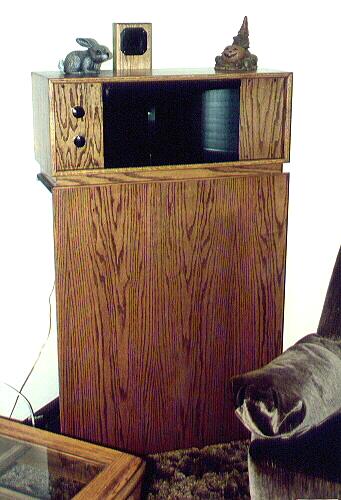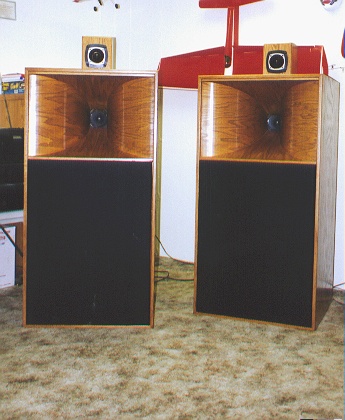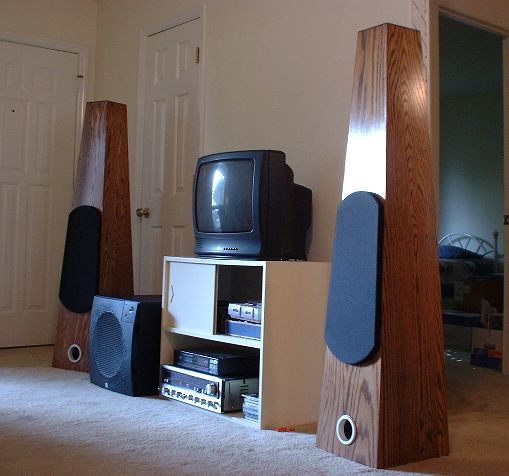

"I built the bass horn of these Klipschorns from Speaker Lab plans. Originally I went by their plans which utilized the normally sealed volume of the top and bottom reflectors but later I sealed them off. bass1.jpg shows the SL version being built. This view shows the 4 upright pieces used in SL plans. The current Klipschorns has 2 wood pieces running the full height of the horn the same depth as the 4 pieces shown in the picture. I found out later that the Klipsch method is better for 2 reasons; (1) it better supports the side walls and stops resonance, and (2) the woofer that I used did not need the additional volume. bass2.jpg, bass3.jpg, and bass4.jpg show the construction phases.
I also made another modification that Bruce Edgar recommended by enlarged the first and second reflector. He claimed it would help the high end of the bass horn. I have no comparison but I would say it made a lot of difference. The response curve I saw from Klipsch shows a dip in response starting at around 300 Hz. My Klipschorns are a little hot between 300-500 Hz. In fact it makes the low end sound a little weak. I really don't know if this was a good modification or not but it did do what he said it would do. The carpet lining the horn mouth shown in bass4.jpg was later removed. This helped the low end some. Bruce said this would stop high frequency peaks that can be a problem sometimes. Bruce also recommended the EVM15L which I used for a while and later replaced it with K-33-E Klipschorn woofers (made by Eminence) which further improved the low end. According to all the horn calculations the EV woofer should have worked better. In my opinion the high Q of the K-33-E improves the bass response because the horn is not acting like a horn at the low end and it relies on the high Q sealed box response to help the low end.
I built the Midrange horns from a Speaker Builder article by Bruce Edgar using the JBL LE5's. I am very pleased with this horn. Bruce recommends crossing it over at 5000 on the high end but I have found that it sounds best crossed higher. The response is a little uneven above 5000hz but it images much better. Currently I am using it without a tweeter. The PR120I1 that I was using didn't mate well with these mids. I constructed the mids horns a little differently than Bruce did in his article. It was very easy and I recommend this method. It makes mounting of the mids in the Klipschorns much easier also. mid1.jpg shows just how easy plywood bends when you cut 1/8 inch kerfs in the back of 3/4 inch oak cabinet plywood. mid2.jpg, mid3.jpg, mid4.jpg, mid5.jpg, and mid6.jpg show the construction in process. Finally I made a modification of my own and made the bass and midrange sections separate. This saved a little wood and made them easier to move and modify if necessary.
imaging.jpg shows the midrange section removed and sitting on a few boxes in front of the bass horn. This improves imaging quite a bit. They also sound good on top but if I had the room I would use them sitting in front."
![]()

My objective with this project was to build a speaker of reasonable cost with superior fidelity using a large 15 X 24 inch Tractrix horn. On my previous Klipschorn project I used a 10 X 18 inch Tractrix which seemed to do well down to 500 Hz. In the past I have found that a Tractrix horn will not go down to the flare cut off. The 15 x 24 inch horn has a flare cut off of 200 and I was hoping to get response down to 300. In reality the finished horn starts dropping off at about 350 Hz. I used a large 3 1/2 inch square throat with a 5 inch MCM paper cone driver part number 55-1595. This is probably not the best driver for this purpose but it did have a fairly large 17 oz. magnet. I think a speaker with a resonance closer to the flare cut off would have been better. The MCM driver's fs is 105 Hz. I'll do more experimentation later. If anyone knows of a good 5 or 6 inch driver with a light weight cone and large magnet let me know, preferably paper cone. Another objective was to get good bass up to the 300 Hz to blend well with the mid horn. I didn't want a large bass horn and also wanted lower response than most folded horns. I found the 18 inch woofer I used in a Parts Express catalog made by Eminence, the Eminence part number is 18-1655. It is rated at 97 dB and seemed to fit my needs. I ended up with a f3 of 38 in a 8.8 cu.ft. box. Yes, that is big but, still smaller than a bass horn. I vented the box out the back to better utilize room boundaries to reinforce the bass. I originally had the box tuned to 30 Hz as calculated but later tuned it higher to about 40 which seemed to increase the bass and dampening. Over all it matched nicely with the mid after I lowered the crossover frequency to the woofer to attenuate it's rising response with frequency. I also used an L-pad on the mids to balance the efficiency. I am guessing the mids are about 102 dB.
The pictures below show some of the construction process.
This jig (jig1.jpg) was used to cut the upper and lower flat section of the midrange horn. I had to hold the wood at the proper angle when I cut the curves with a band saw to avoid any gaps where the curved wood meets the flat pieces. In the Klipschorns I used wood filler to over come this problem but in this case I intended on finishing the wood with a clear finish and could not have gaps in the joints.
Another jig (jig2.jpg) was necessary to clamp the kerfed plywood against the flat upper and lower pieces. (jig3.jpg) shows the horn clamped in place. I used 5 minute epoxy during assembly because of its ability to fill any gaps. As you can imagine I had to work quick. As it turned the joints fit well enough that I only had to use a small amount of wood filler and regular yellow glue would probably have worked just as well. (mhorn1.jpg) and (mhorn2.jpg) show the horn after it came off the jig.
After assembling the mids I installed them in the speaker cabinets (front1.jpg) and fitted the back of the horns with a sub enclosure (mchamber.jpg) for free air operation. I found this sounded better than any size sealed enclosure. I think maybe a sealed box would have worked well if the resonance of the driver was a little higher. Later I modified the mounting of the mid driver with 1/4 inch thick spacers and filled the gap with Dacron sheet batting (mod.jpg) This is a trick I learned from Bruce Edgar. It puts a restrictive gap between the driver and throat which eliminated low end peaks and smoothed the resonance. (back1.jpg) shows the back chamber and ports which were later enlarged for a higher tuning frequency. And finally here is a picture of me which gives a good size comparison (mespeak2.jpg).
I ended up using a Selenium tweeter ST304. I chose this tweeter because of its good low end response and narrow dispersion pattern (for better imaging). It matched the mids quite well after several resisters and an L-pad were installed. It is 106 dB efficient which is WAY too sensitive. I would not use it again because of this. It isn't the best on the extreme high end either. Used as intended (to fill a stadium!) it would probably be a good tweeter.
Overall I'm very happy with the speakers. They probably sound a little better than the Klipschorns because of the larger mids and the smooth roll off on the low end.
![]()

![]()